Software Engineering Workshop: Railway Time Table Application Report
VerifiedAdded on 2023/06/04
|15
|1825
|409
Report
AI Summary
This report details the development of a railway timetable application as part of a Software Engineering Workshop. The project encompasses team and project management, including team effectiveness and the Software Development Life Cycle (SDLC) phases: analysis, design, implementation, quality assurance, deployment, and support/maintenance. The analysis phase defines functional and non-functional requirements, including user interface requirements and use cases. The design phase includes a class diagram, basic UI designs for menu, origin/destination filtering, journey duration calculation, and real-time LDBS, along with a sequence diagram. The implementation section mentions the source code. The evaluation, testing, and profiling section covers test-driven development (TDD) with a storyboard, and test evaluation. The application was successfully developed using Java, providing information on railway timetables. The report concludes with reflections on the project's success and references.
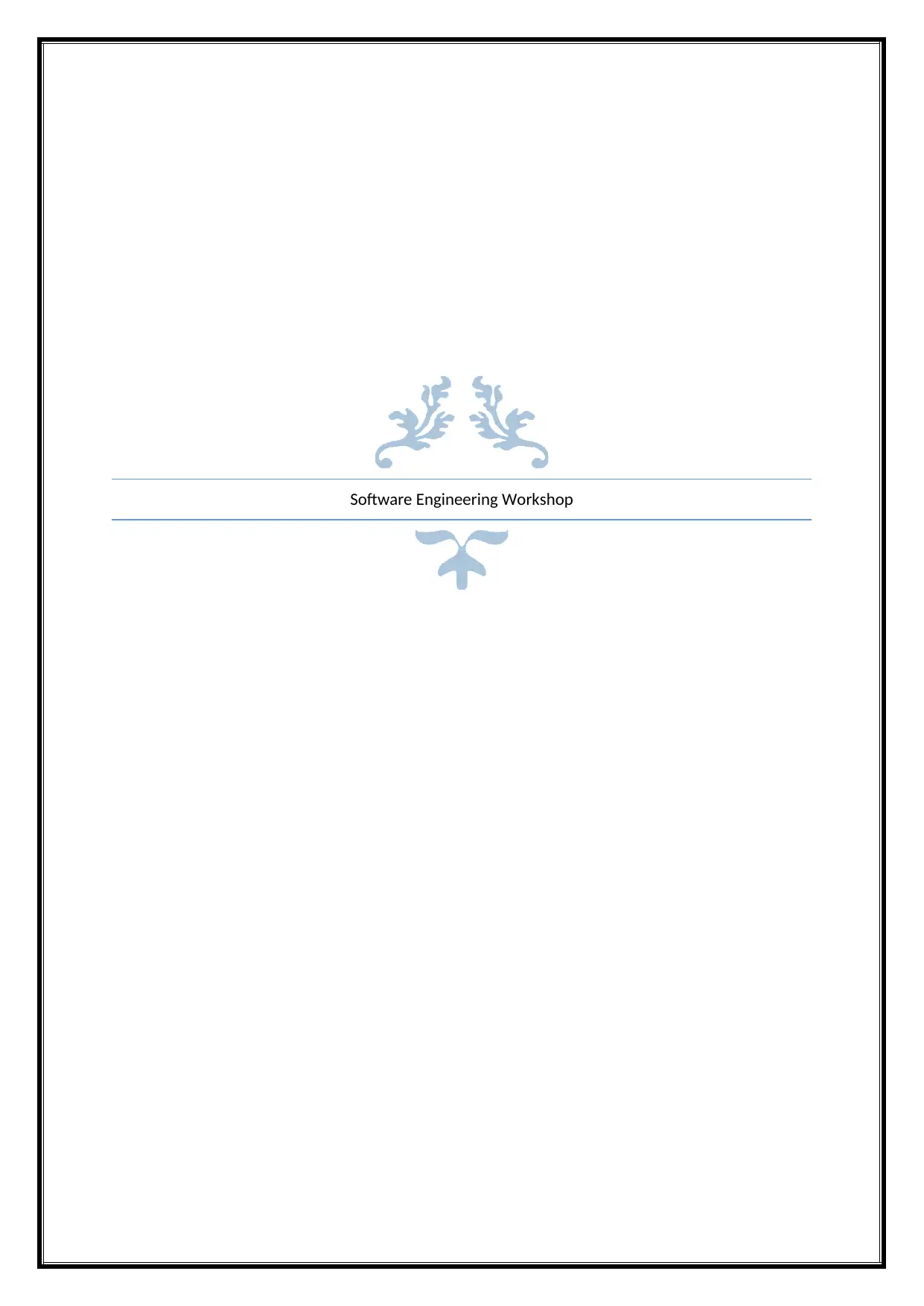
Software Engineering Workshop
Paraphrase This Document
Need a fresh take? Get an instant paraphrase of this document with our AI Paraphraser
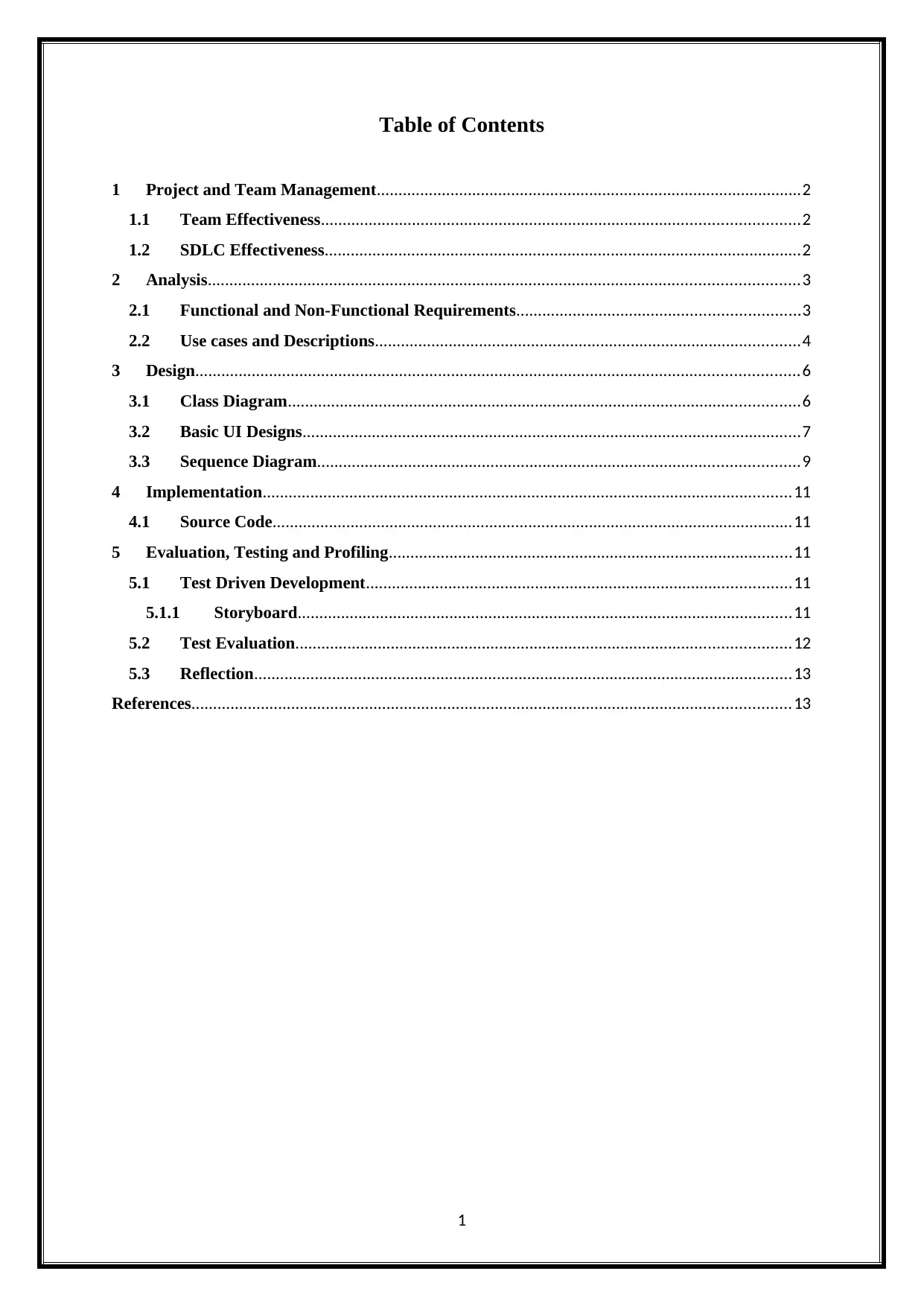
Table of Contents
1 Project and Team Management..................................................................................................2
1.1 Team Effectiveness..............................................................................................................2
1.2 SDLC Effectiveness..............................................................................................................2
2 Analysis........................................................................................................................................3
2.1 Functional and Non-Functional Requirements.................................................................3
2.2 Use cases and Descriptions..................................................................................................4
3 Design...........................................................................................................................................6
3.1 Class Diagram......................................................................................................................6
3.2 Basic UI Designs...................................................................................................................7
3.3 Sequence Diagram...............................................................................................................9
4 Implementation..........................................................................................................................11
4.1 Source Code........................................................................................................................11
5 Evaluation, Testing and Profiling.............................................................................................11
5.1 Test Driven Development..................................................................................................11
5.1.1 Storyboard..................................................................................................................11
5.2 Test Evaluation..................................................................................................................12
5.3 Reflection............................................................................................................................13
References..........................................................................................................................................13
1
1 Project and Team Management..................................................................................................2
1.1 Team Effectiveness..............................................................................................................2
1.2 SDLC Effectiveness..............................................................................................................2
2 Analysis........................................................................................................................................3
2.1 Functional and Non-Functional Requirements.................................................................3
2.2 Use cases and Descriptions..................................................................................................4
3 Design...........................................................................................................................................6
3.1 Class Diagram......................................................................................................................6
3.2 Basic UI Designs...................................................................................................................7
3.3 Sequence Diagram...............................................................................................................9
4 Implementation..........................................................................................................................11
4.1 Source Code........................................................................................................................11
5 Evaluation, Testing and Profiling.............................................................................................11
5.1 Test Driven Development..................................................................................................11
5.1.1 Storyboard..................................................................................................................11
5.2 Test Evaluation..................................................................................................................12
5.3 Reflection............................................................................................................................13
References..........................................................................................................................................13
1
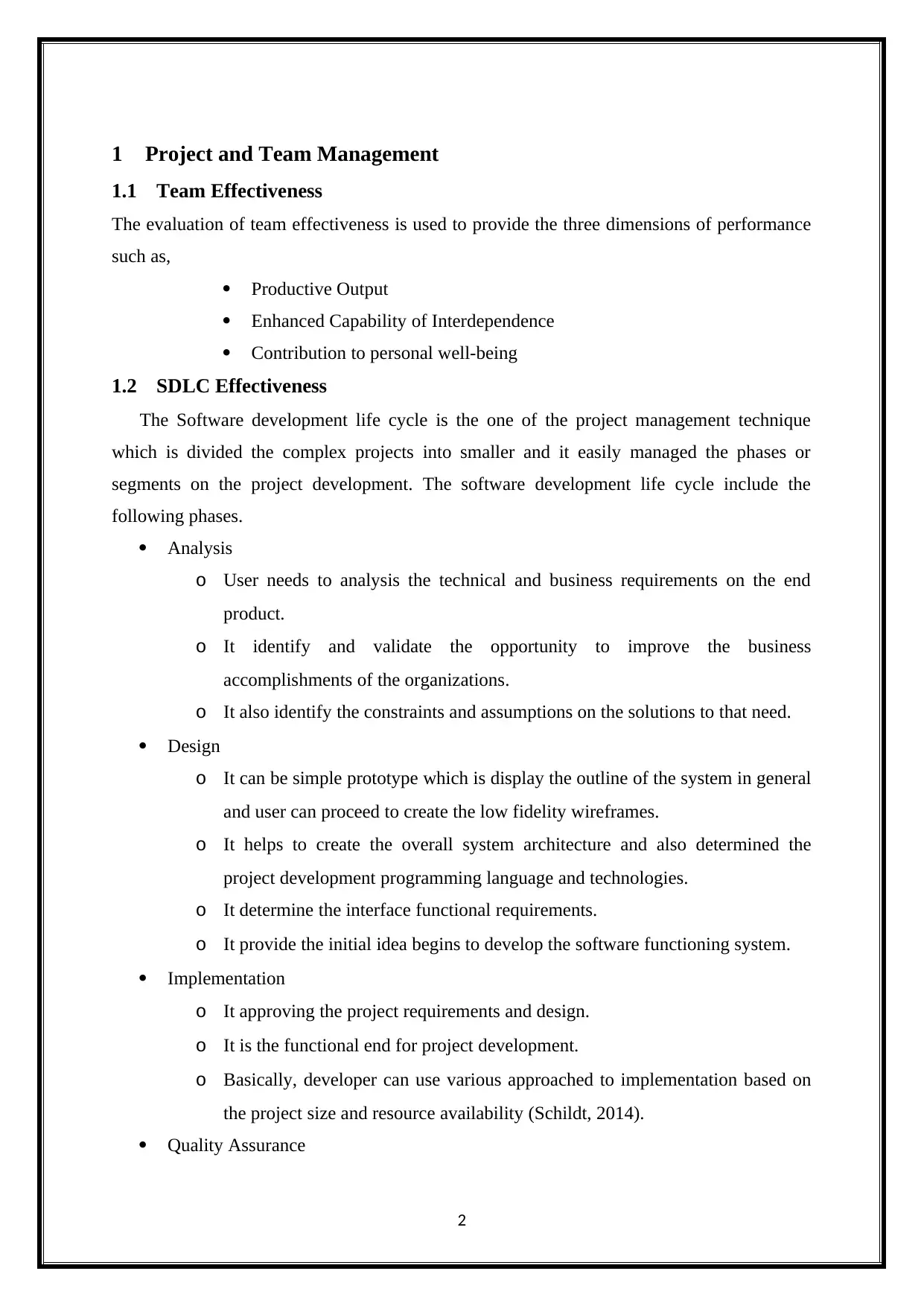
1 Project and Team Management
1.1 Team Effectiveness
The evaluation of team effectiveness is used to provide the three dimensions of performance
such as,
Productive Output
Enhanced Capability of Interdependence
Contribution to personal well-being
1.2 SDLC Effectiveness
The Software development life cycle is the one of the project management technique
which is divided the complex projects into smaller and it easily managed the phases or
segments on the project development. The software development life cycle include the
following phases.
Analysis
o User needs to analysis the technical and business requirements on the end
product.
o It identify and validate the opportunity to improve the business
accomplishments of the organizations.
o It also identify the constraints and assumptions on the solutions to that need.
Design
o It can be simple prototype which is display the outline of the system in general
and user can proceed to create the low fidelity wireframes.
o It helps to create the overall system architecture and also determined the
project development programming language and technologies.
o It determine the interface functional requirements.
o It provide the initial idea begins to develop the software functioning system.
Implementation
o It approving the project requirements and design.
o It is the functional end for project development.
o Basically, developer can use various approached to implementation based on
the project size and resource availability (Schildt, 2014).
Quality Assurance
2
1.1 Team Effectiveness
The evaluation of team effectiveness is used to provide the three dimensions of performance
such as,
Productive Output
Enhanced Capability of Interdependence
Contribution to personal well-being
1.2 SDLC Effectiveness
The Software development life cycle is the one of the project management technique
which is divided the complex projects into smaller and it easily managed the phases or
segments on the project development. The software development life cycle include the
following phases.
Analysis
o User needs to analysis the technical and business requirements on the end
product.
o It identify and validate the opportunity to improve the business
accomplishments of the organizations.
o It also identify the constraints and assumptions on the solutions to that need.
Design
o It can be simple prototype which is display the outline of the system in general
and user can proceed to create the low fidelity wireframes.
o It helps to create the overall system architecture and also determined the
project development programming language and technologies.
o It determine the interface functional requirements.
o It provide the initial idea begins to develop the software functioning system.
Implementation
o It approving the project requirements and design.
o It is the functional end for project development.
o Basically, developer can use various approached to implementation based on
the project size and resource availability (Schildt, 2014).
Quality Assurance
2
⊘ This is a preview!⊘
Do you want full access?
Subscribe today to unlock all pages.

Trusted by 1+ million students worldwide
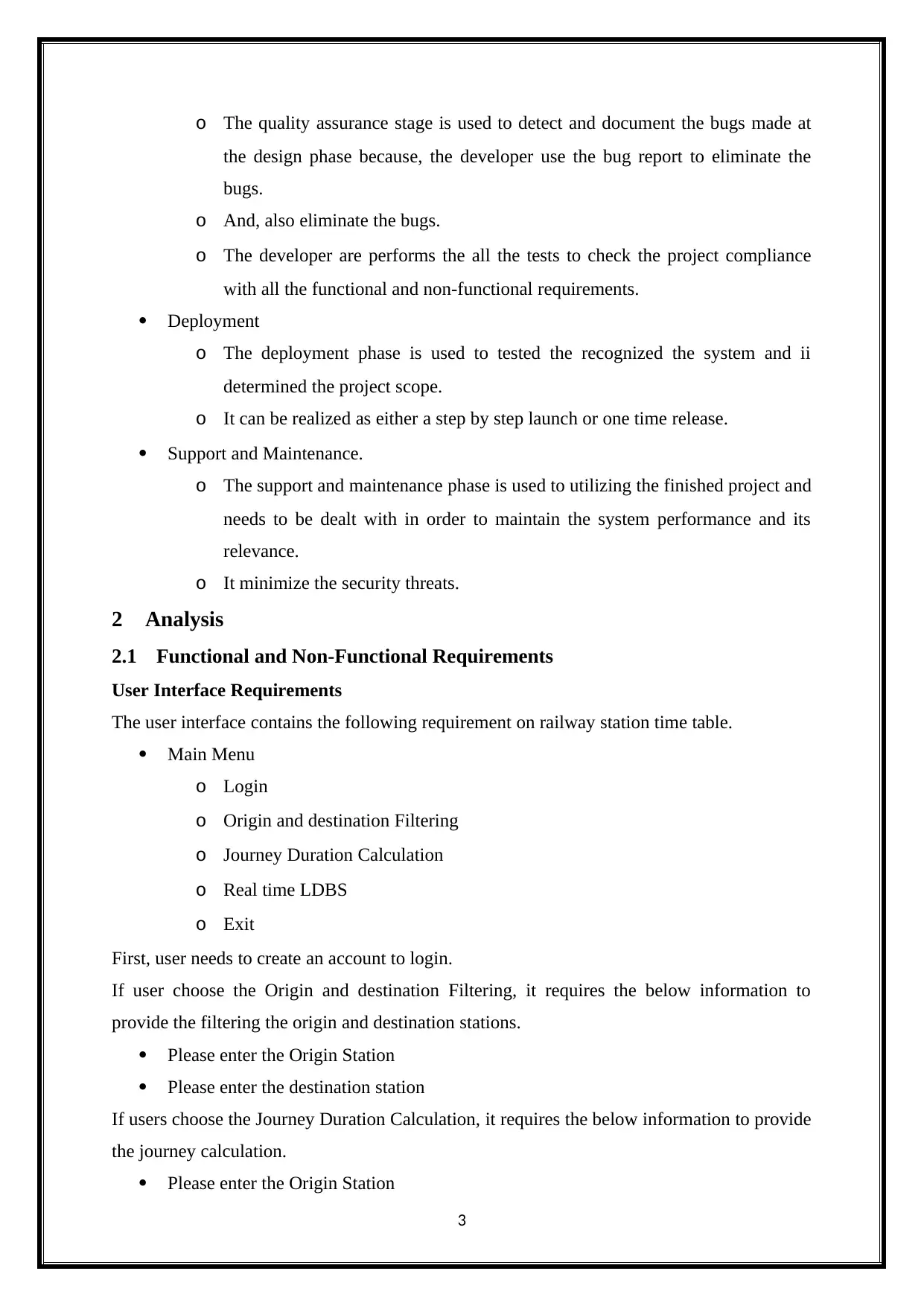
o The quality assurance stage is used to detect and document the bugs made at
the design phase because, the developer use the bug report to eliminate the
bugs.
o And, also eliminate the bugs.
o The developer are performs the all the tests to check the project compliance
with all the functional and non-functional requirements.
Deployment
o The deployment phase is used to tested the recognized the system and ii
determined the project scope.
o It can be realized as either a step by step launch or one time release.
Support and Maintenance.
o The support and maintenance phase is used to utilizing the finished project and
needs to be dealt with in order to maintain the system performance and its
relevance.
o It minimize the security threats.
2 Analysis
2.1 Functional and Non-Functional Requirements
User Interface Requirements
The user interface contains the following requirement on railway station time table.
Main Menu
o Login
o Origin and destination Filtering
o Journey Duration Calculation
o Real time LDBS
o Exit
First, user needs to create an account to login.
If user choose the Origin and destination Filtering, it requires the below information to
provide the filtering the origin and destination stations.
Please enter the Origin Station
Please enter the destination station
If users choose the Journey Duration Calculation, it requires the below information to provide
the journey calculation.
Please enter the Origin Station
3
the design phase because, the developer use the bug report to eliminate the
bugs.
o And, also eliminate the bugs.
o The developer are performs the all the tests to check the project compliance
with all the functional and non-functional requirements.
Deployment
o The deployment phase is used to tested the recognized the system and ii
determined the project scope.
o It can be realized as either a step by step launch or one time release.
Support and Maintenance.
o The support and maintenance phase is used to utilizing the finished project and
needs to be dealt with in order to maintain the system performance and its
relevance.
o It minimize the security threats.
2 Analysis
2.1 Functional and Non-Functional Requirements
User Interface Requirements
The user interface contains the following requirement on railway station time table.
Main Menu
o Login
o Origin and destination Filtering
o Journey Duration Calculation
o Real time LDBS
o Exit
First, user needs to create an account to login.
If user choose the Origin and destination Filtering, it requires the below information to
provide the filtering the origin and destination stations.
Please enter the Origin Station
Please enter the destination station
If users choose the Journey Duration Calculation, it requires the below information to provide
the journey calculation.
Please enter the Origin Station
3
Paraphrase This Document
Need a fresh take? Get an instant paraphrase of this document with our AI Paraphraser
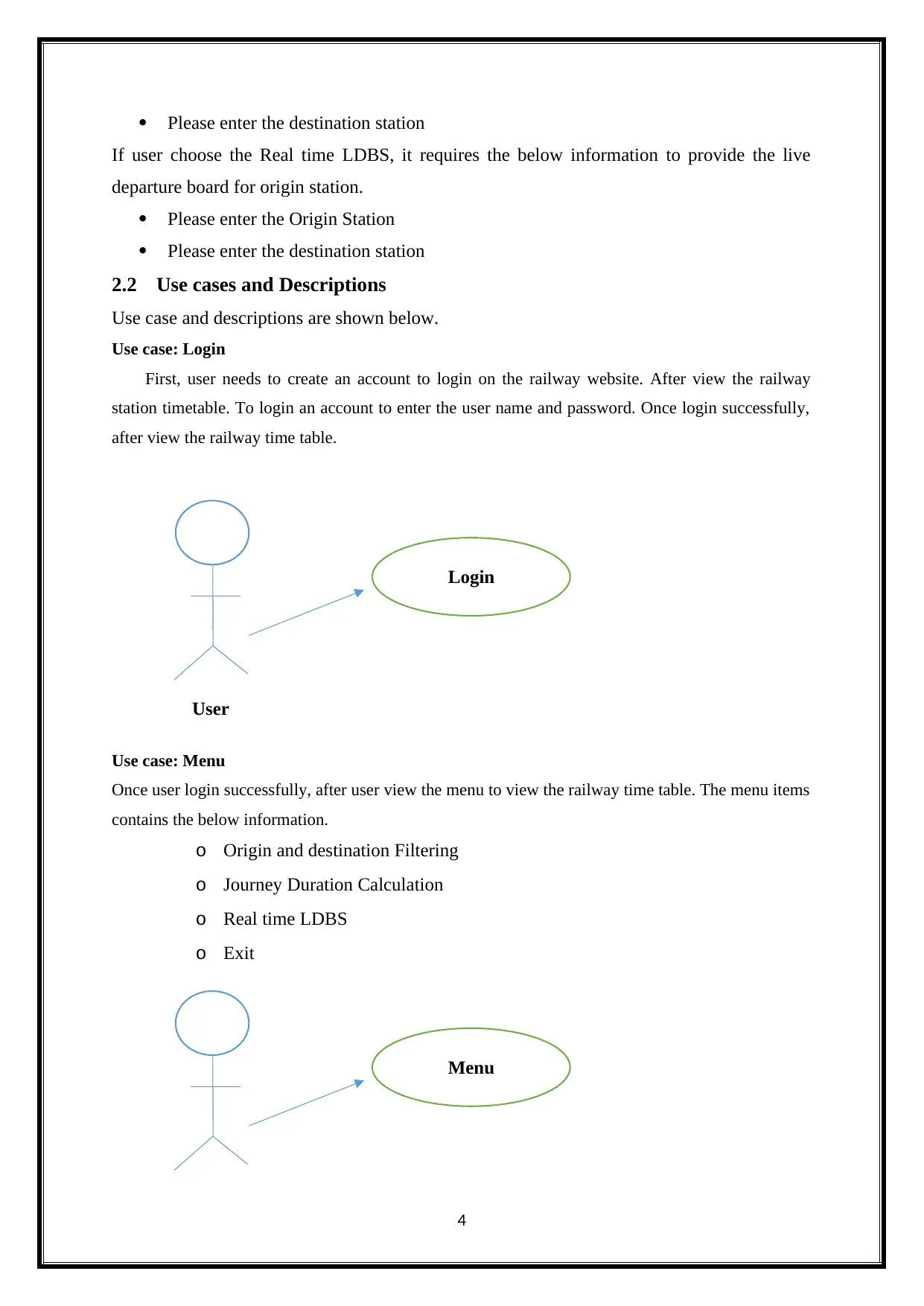
Please enter the destination station
If user choose the Real time LDBS, it requires the below information to provide the live
departure board for origin station.
Please enter the Origin Station
Please enter the destination station
2.2 Use cases and Descriptions
Use case and descriptions are shown below.
Use case: Login
First, user needs to create an account to login on the railway website. After view the railway
station timetable. To login an account to enter the user name and password. Once login successfully,
after view the railway time table.
Use case: Menu
Once user login successfully, after user view the menu to view the railway time table. The menu items
contains the below information.
o Origin and destination Filtering
o Journey Duration Calculation
o Real time LDBS
o Exit
4
Login
User
Menu
If user choose the Real time LDBS, it requires the below information to provide the live
departure board for origin station.
Please enter the Origin Station
Please enter the destination station
2.2 Use cases and Descriptions
Use case and descriptions are shown below.
Use case: Login
First, user needs to create an account to login on the railway website. After view the railway
station timetable. To login an account to enter the user name and password. Once login successfully,
after view the railway time table.
Use case: Menu
Once user login successfully, after user view the menu to view the railway time table. The menu items
contains the below information.
o Origin and destination Filtering
o Journey Duration Calculation
o Real time LDBS
o Exit
4
Login
User
Menu
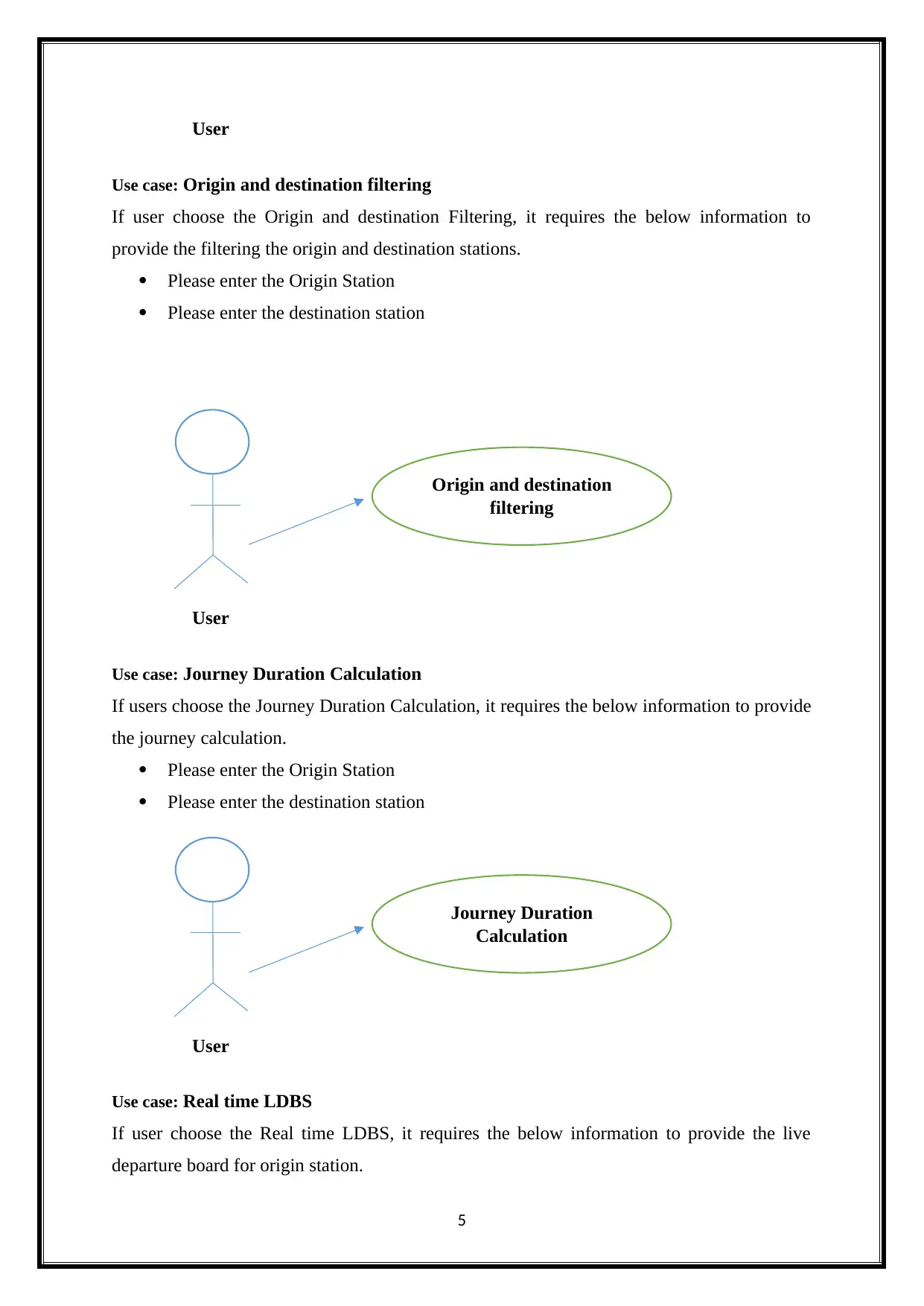
Use case: Origin and destination filtering
If user choose the Origin and destination Filtering, it requires the below information to
provide the filtering the origin and destination stations.
Please enter the Origin Station
Please enter the destination station
Use case: Journey Duration Calculation
If users choose the Journey Duration Calculation, it requires the below information to provide
the journey calculation.
Please enter the Origin Station
Please enter the destination station
Use case: Real time LDBS
If user choose the Real time LDBS, it requires the below information to provide the live
departure board for origin station.
5
User
Origin and destination
filtering
User
Journey Duration
Calculation
User
If user choose the Origin and destination Filtering, it requires the below information to
provide the filtering the origin and destination stations.
Please enter the Origin Station
Please enter the destination station
Use case: Journey Duration Calculation
If users choose the Journey Duration Calculation, it requires the below information to provide
the journey calculation.
Please enter the Origin Station
Please enter the destination station
Use case: Real time LDBS
If user choose the Real time LDBS, it requires the below information to provide the live
departure board for origin station.
5
User
Origin and destination
filtering
User
Journey Duration
Calculation
User
⊘ This is a preview!⊘
Do you want full access?
Subscribe today to unlock all pages.

Trusted by 1+ million students worldwide

Please enter the Origin Station
Please enter the destination station
3 Design
3.1 Class Diagram
The Railway time table class diagram is shown below.
In class diagram, it has four classes such as user class, railway time table class, LDBs
class and Menu class. The User class has following objects such as user name and password.
The railway timetable has following objects such as station/ stop and time of the day. The
Menu class contains the following objects such as Login, Origin and destination Filtering,
Journey Duration Calculation and Real time LDBS.
6
Real time LDBS
User
Please enter the destination station
3 Design
3.1 Class Diagram
The Railway time table class diagram is shown below.
In class diagram, it has four classes such as user class, railway time table class, LDBs
class and Menu class. The User class has following objects such as user name and password.
The railway timetable has following objects such as station/ stop and time of the day. The
Menu class contains the following objects such as Login, Origin and destination Filtering,
Journey Duration Calculation and Real time LDBS.
6
Real time LDBS
User
Paraphrase This Document
Need a fresh take? Get an instant paraphrase of this document with our AI Paraphraser
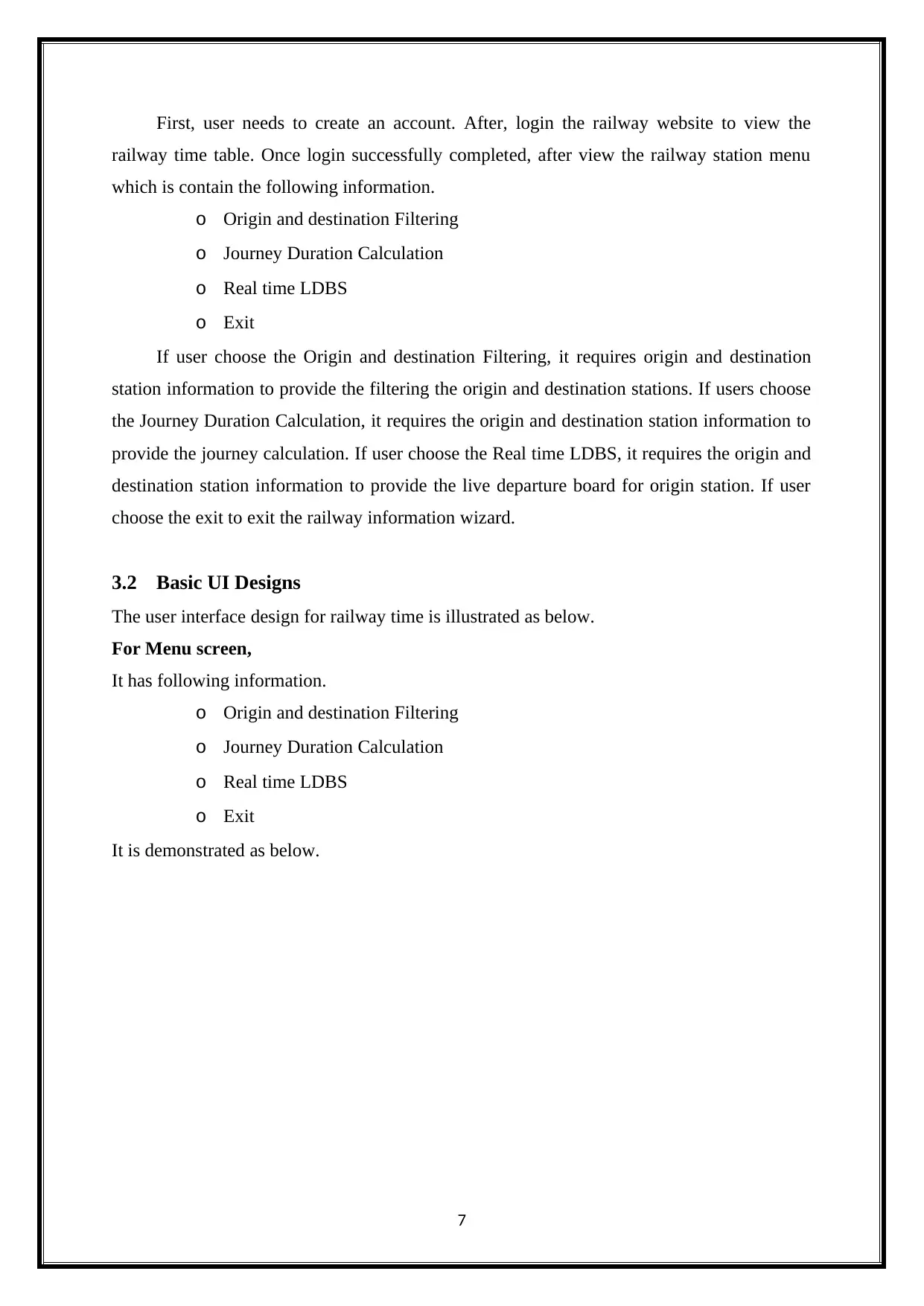
First, user needs to create an account. After, login the railway website to view the
railway time table. Once login successfully completed, after view the railway station menu
which is contain the following information.
o Origin and destination Filtering
o Journey Duration Calculation
o Real time LDBS
o Exit
If user choose the Origin and destination Filtering, it requires origin and destination
station information to provide the filtering the origin and destination stations. If users choose
the Journey Duration Calculation, it requires the origin and destination station information to
provide the journey calculation. If user choose the Real time LDBS, it requires the origin and
destination station information to provide the live departure board for origin station. If user
choose the exit to exit the railway information wizard.
3.2 Basic UI Designs
The user interface design for railway time is illustrated as below.
For Menu screen,
It has following information.
o Origin and destination Filtering
o Journey Duration Calculation
o Real time LDBS
o Exit
It is demonstrated as below.
7
railway time table. Once login successfully completed, after view the railway station menu
which is contain the following information.
o Origin and destination Filtering
o Journey Duration Calculation
o Real time LDBS
o Exit
If user choose the Origin and destination Filtering, it requires origin and destination
station information to provide the filtering the origin and destination stations. If users choose
the Journey Duration Calculation, it requires the origin and destination station information to
provide the journey calculation. If user choose the Real time LDBS, it requires the origin and
destination station information to provide the live departure board for origin station. If user
choose the exit to exit the railway information wizard.
3.2 Basic UI Designs
The user interface design for railway time is illustrated as below.
For Menu screen,
It has following information.
o Origin and destination Filtering
o Journey Duration Calculation
o Real time LDBS
o Exit
It is demonstrated as below.
7
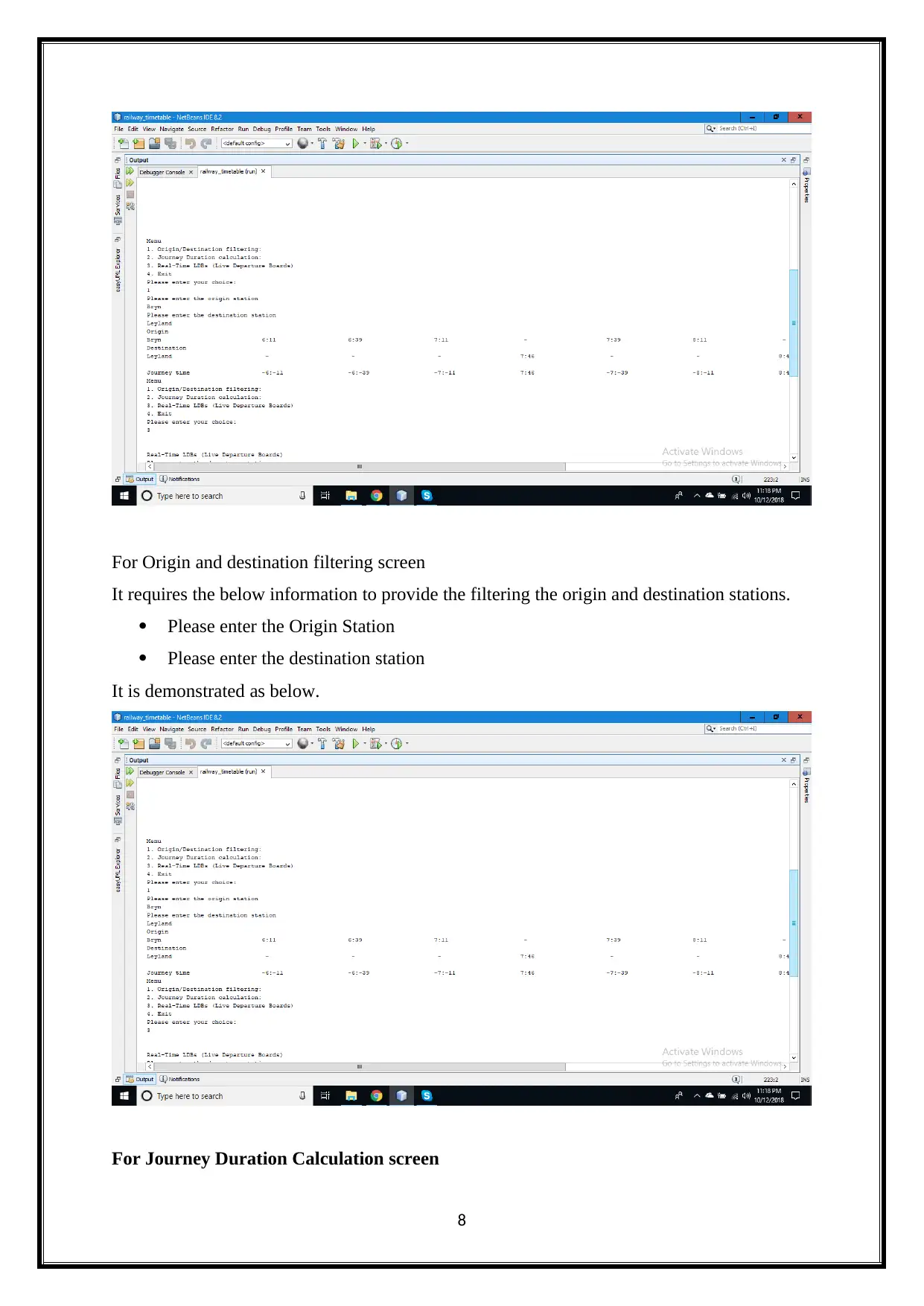
For Origin and destination filtering screen
It requires the below information to provide the filtering the origin and destination stations.
Please enter the Origin Station
Please enter the destination station
It is demonstrated as below.
For Journey Duration Calculation screen
8
It requires the below information to provide the filtering the origin and destination stations.
Please enter the Origin Station
Please enter the destination station
It is demonstrated as below.
For Journey Duration Calculation screen
8
⊘ This is a preview!⊘
Do you want full access?
Subscribe today to unlock all pages.

Trusted by 1+ million students worldwide
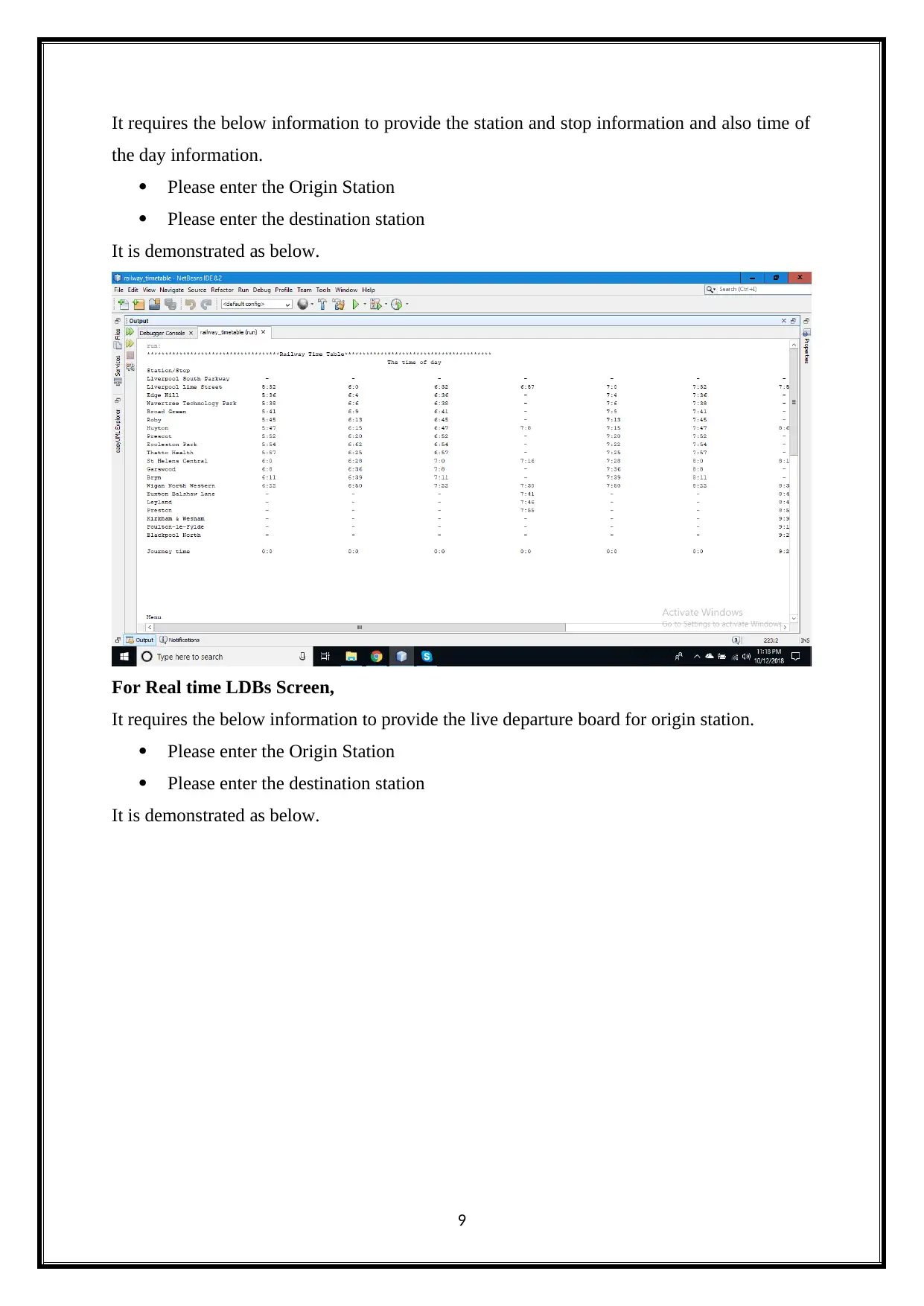
It requires the below information to provide the station and stop information and also time of
the day information.
Please enter the Origin Station
Please enter the destination station
It is demonstrated as below.
For Real time LDBs Screen,
It requires the below information to provide the live departure board for origin station.
Please enter the Origin Station
Please enter the destination station
It is demonstrated as below.
9
the day information.
Please enter the Origin Station
Please enter the destination station
It is demonstrated as below.
For Real time LDBs Screen,
It requires the below information to provide the live departure board for origin station.
Please enter the Origin Station
Please enter the destination station
It is demonstrated as below.
9
Paraphrase This Document
Need a fresh take? Get an instant paraphrase of this document with our AI Paraphraser
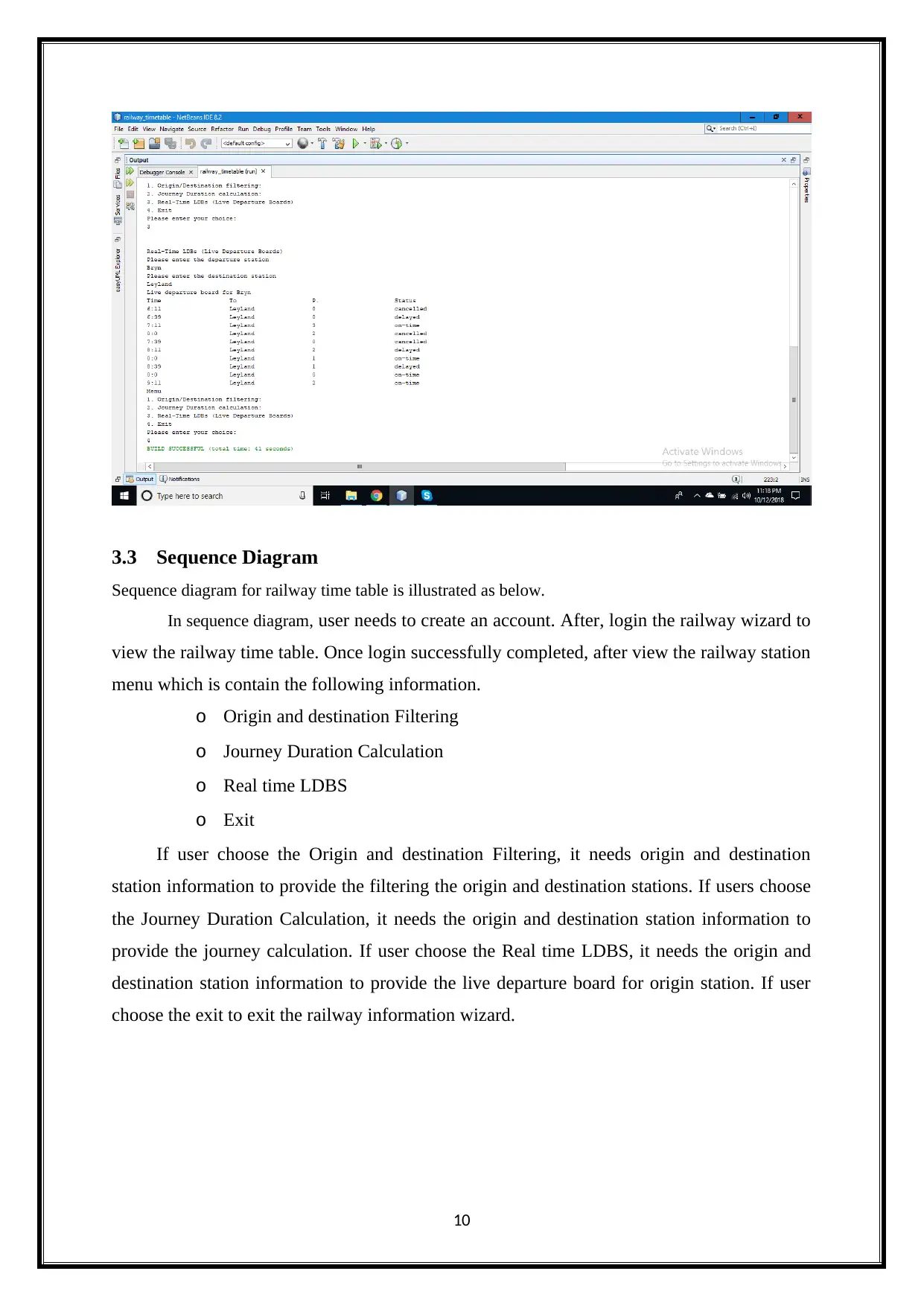
3.3 Sequence Diagram
Sequence diagram for railway time table is illustrated as below.
In sequence diagram, user needs to create an account. After, login the railway wizard to
view the railway time table. Once login successfully completed, after view the railway station
menu which is contain the following information.
o Origin and destination Filtering
o Journey Duration Calculation
o Real time LDBS
o Exit
If user choose the Origin and destination Filtering, it needs origin and destination
station information to provide the filtering the origin and destination stations. If users choose
the Journey Duration Calculation, it needs the origin and destination station information to
provide the journey calculation. If user choose the Real time LDBS, it needs the origin and
destination station information to provide the live departure board for origin station. If user
choose the exit to exit the railway information wizard.
10
Sequence diagram for railway time table is illustrated as below.
In sequence diagram, user needs to create an account. After, login the railway wizard to
view the railway time table. Once login successfully completed, after view the railway station
menu which is contain the following information.
o Origin and destination Filtering
o Journey Duration Calculation
o Real time LDBS
o Exit
If user choose the Origin and destination Filtering, it needs origin and destination
station information to provide the filtering the origin and destination stations. If users choose
the Journey Duration Calculation, it needs the origin and destination station information to
provide the journey calculation. If user choose the Real time LDBS, it needs the origin and
destination station information to provide the live departure board for origin station. If user
choose the exit to exit the railway information wizard.
10
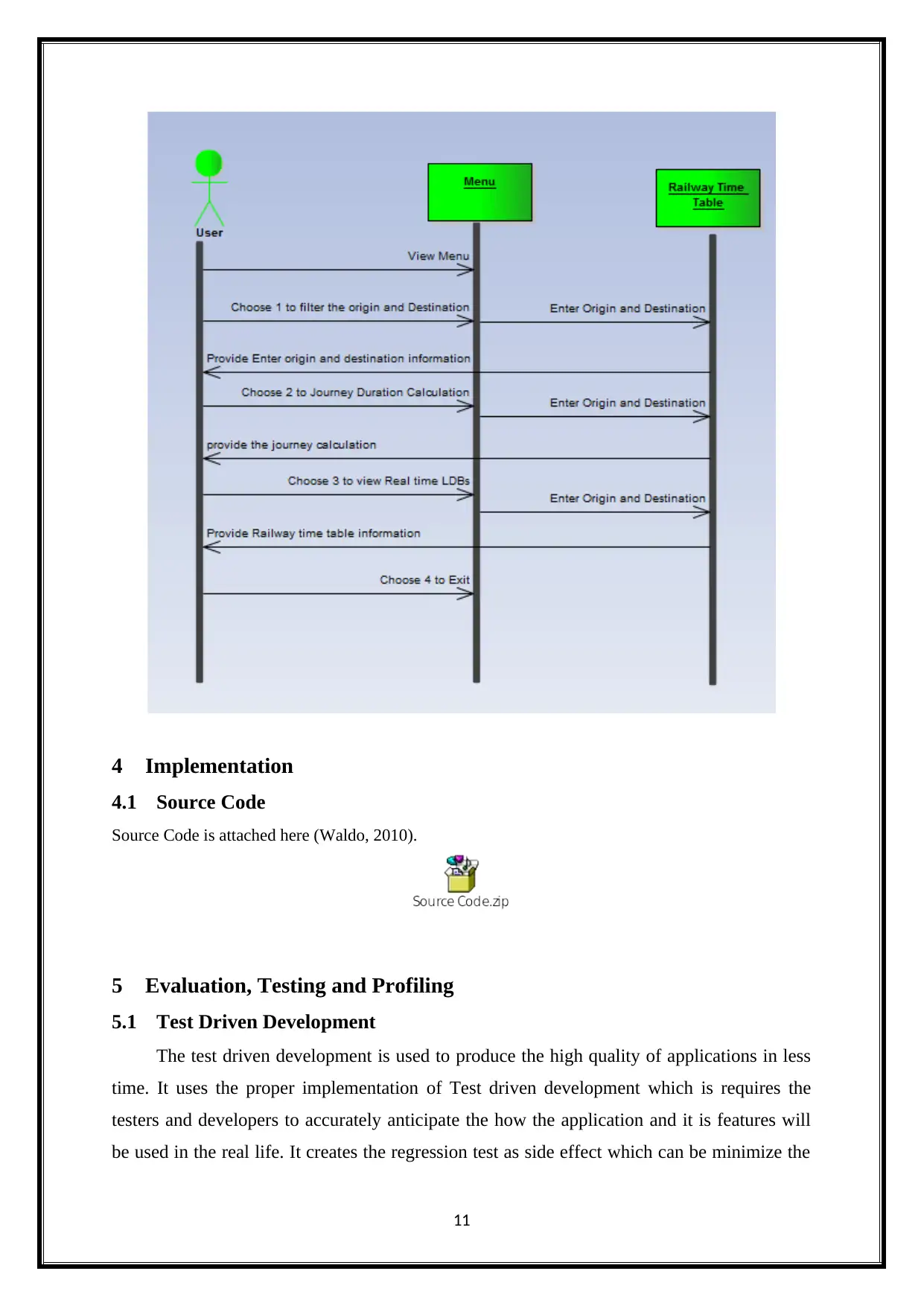
4 Implementation
4.1 Source Code
Source Code is attached here (Waldo, 2010).
5 Evaluation, Testing and Profiling
5.1 Test Driven Development
The test driven development is used to produce the high quality of applications in less
time. It uses the proper implementation of Test driven development which is requires the
testers and developers to accurately anticipate the how the application and it is features will
be used in the real life. It creates the regression test as side effect which can be minimize the
11
4.1 Source Code
Source Code is attached here (Waldo, 2010).
5 Evaluation, Testing and Profiling
5.1 Test Driven Development
The test driven development is used to produce the high quality of applications in less
time. It uses the proper implementation of Test driven development which is requires the
testers and developers to accurately anticipate the how the application and it is features will
be used in the real life. It creates the regression test as side effect which can be minimize the
11
⊘ This is a preview!⊘
Do you want full access?
Subscribe today to unlock all pages.

Trusted by 1+ million students worldwide
1 out of 15
Related Documents
Your All-in-One AI-Powered Toolkit for Academic Success.
+13062052269
info@desklib.com
Available 24*7 on WhatsApp / Email
![[object Object]](/_next/static/media/star-bottom.7253800d.svg)
Unlock your academic potential
Copyright © 2020–2025 A2Z Services. All Rights Reserved. Developed and managed by ZUCOL.




![Software Testing and Deployment Portfolio Report - [University Name]](/_next/image/?url=https%3A%2F%2Fdesklib.com%2Fmedia%2Fimages%2Fdo%2Fc67868a793f1481d9f641a659c033621.jpg&w=256&q=75)
